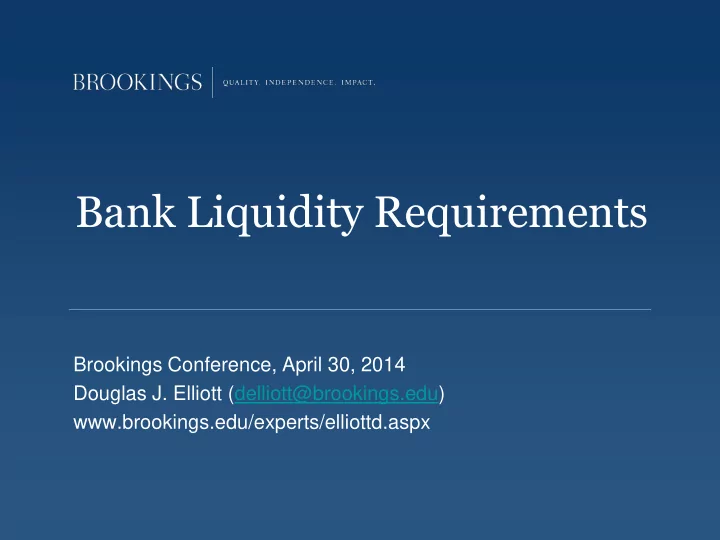

Bank Liquidity Requirements Brookings Conference, April 30, 2014 Douglas J. Elliott (delliott@brookings.edu) www.brookings.edu/experts/elliottd.aspx
2 Liquidity Matters for Banks • Banks have always been vulnerable to runs, since they make multi-year loans using deposit funding • The lender of last resort function is designed to help protect solvent banks from such runs • But, we want banks to handle the vast majority of liquidity scenarios without invoking LOLR facilities » Decreases frequency and size of LOLR demands » Reduces problems caused by fire sales
3 Banks were too illiquid pre-crisis • Liquidity regulation and supervision was fairly loose, without the equivalent of the Basel capital standards • Liquidity seemed abundant and likely to remain so • Banks therefore generally chose not to increase expenses » Did not pay up for enough long-term funding » Did not lose income by holding enough short-term, safe assets
4 New Liquidity Rules are Being Put in Place • Liquidity Coverage Ratio (LCR) in Basel III (as of 2015) • Net Stable Funding Ratio (NSFR) in Basel III (as of 2018) • Liquidity stress tests • More careful liquidity supervision
5 Liquidity Coverage Ratio (LCR) • Essentially a stylized stress test to see if a bank could handle 30 days of a market liquidity crisis on its own • Funding sources are assumed to dry up to varying extents » Runoff of deposits and wholesale funding » Haircuts on asset values • Funding demands are assumed to rise » Drawdowns on credit facilities • The minimum 100% level means there would be just enough funds available to cover all the outflows
6 Net Stable Funding Ratio (NSFR) • LCR is intended to check ability to handle sudden crisis • NSFR is intended to check underlying vulnerability to liquidity issues, to discourage dangerous business models • Available Stable Funding (ASF) » 95% of “stable” deposits » 50% of funding from non-financial customers • Required Stable Funding (RSF) » Portions of credit lines are assumed to be drawn down » Haircuts on securities
Recommend
More recommend